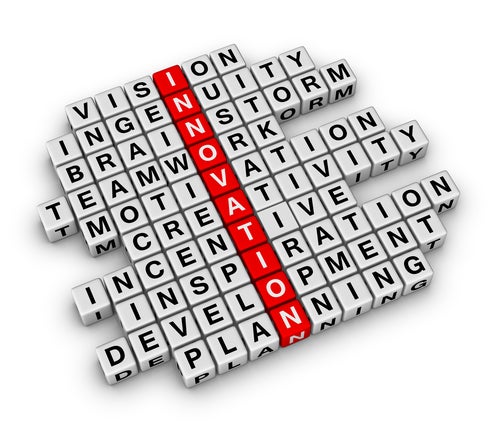
Or perhaps in cuisine, like chocolate-dipped bacon.
(That might just be one of the best uses for chocolate since its marriage with peanut butter!)
But innovation is often born from small things, and it requires a fundamental element to exist within an organization's culture. That's trust.
This article is part of a series that is dedicated to finding a greater understanding of the contribution of human capital assets (people) to the overall valuation of a business enterprise.
Afterall, the value of a business is a function of how well the financial capital and intellectual capital are deployed by the human capital.
If you're just joining us, welcome to The New ROI: Return on Individuals.
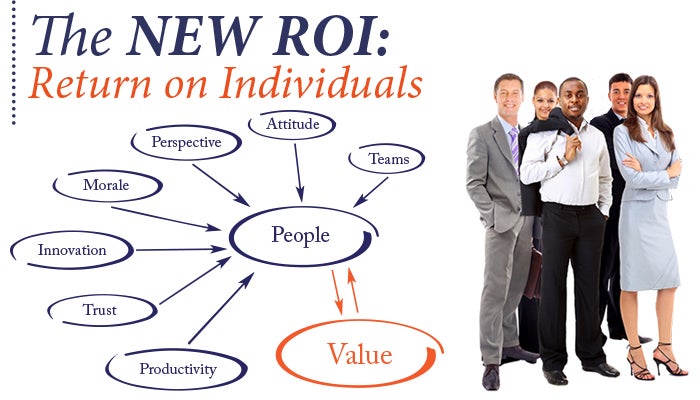
If you'd like to learn the "Why" behind this series, you can click here and if you'd like to join a community of people who believe that people are a company's most valuable asset, you can click here for our LinkedIn Group or click here for our Facebook Group. Yes, you can join both!
In this chapter of The New ROI: Return On Individuals, we discuss the importance of trust for innovation.

Where Do The Good Ideas Come From?
Not all innovation represents a seismic shift from the status quo. Sometimes very small tweaks to a process can result in time savings or quality improvements. And who better to get such ideas from than the people in the trenches who would know best? Perhaps one of the more critical elements for innovation is trust.
When trust goes up, fear goes down; and vice versa. When people work or play well together, it means that there is high trust in the group, and trust leads to innovation. Meet Art Dimitri, an expert on innovation. Art believes that the best ideas come from a company's employees. Unfortunately, many great ideas never see the light of day.
But why is that?
Art spent his career being responsible for driving innovation at various firms. Innovation is also somewhat of a hobby for him - it's just who he is.

Wherever he goes, Art keenly observes employee interactions and he likes to ask the employees questions, like “What would you do if you had a great idea that would really improve the way things are run? Is there a process for that and would you be comfortable doing it?”
I’ve been in Art's company when he's done this and observed first-hand some of the responses. Some employees said that management doesn’t seem to welcome ideas – "they’re certainly not requested."
Some employees said that they would likely share the idea with their immediate supervisor but they didn’t know what any next steps were after that, or if they should expect any kind of feedback. Some employees just didn't think it was worth the effort.
But why wouldn't it be worth the effort?

Who Exactly Is Taking The Risk?
As an organization, you want your people to be engaged and comfortable to submit their ideas. Don't you?
For an employee to think about idea generation, they're going to assume a fair amount of risk. Risk that they might be ridiculed for making a "silly" suggestion; or risk that they might not be rewarded if their idea leads to something great. Or even the risk of working on a project that "fails" could be damaging to their career.
Art shares a story about a supermarket produce manager with more than 25 years of experience. Two months earlier, his former employer was acquired by another supermarket chain.

When Art asked how interested the new management team was in his ideas for best practices in displaying fruits and vegetables, he said "they weren't." No one asked him anything, but they were very quick to teach him their way. He felt the message was clear: their way was the right way.
Art puts it this way:
"An employee's fear of failure destroys the trust to experiment that is required for innovation."
The Business Case For Trust
Great Place to Work ("GPTW") is a leading authority on building and recognizing high-trust, high-performing workplace cultures. Their 30 years of research in numerous countries around the world, has shown repeatedly that investing in a high-trust workplace culture yields tangible business benefits.
GPTW has found that employees experience high levels of trust in the workplace when they:
- Believe leaders are credible (i.e., competent, communicative, honest).
- Believe they are treated with respect as people and professionals.
- Believe the workplace is fundamentally fair.
The GPTW annual studies of the Fortune100 Best Companies to Work For show that great workplaces enjoy almost 3 times better financial performance than their industry peers.
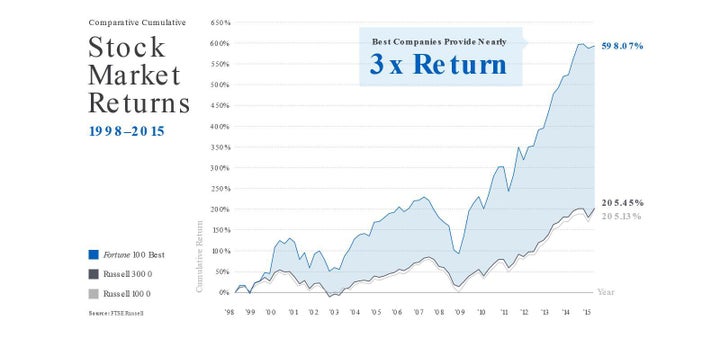
Those companies also experience improved track records on higher customer satisfaction, improved employee morale, safety, higher quality job applicants, and innovation.
Annualized returns for high-trust-culture companies also exceed the overall market.
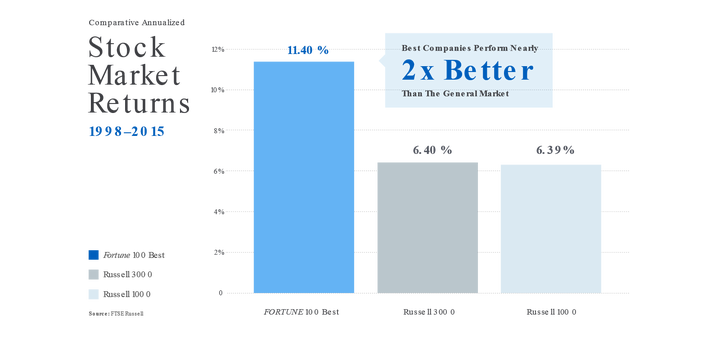
In a study led by Luigi Guiso, of the Einaudi Institute for Economics and Finance, demonstrated that of roughly 700 companies that completed the Great Place to Work Trust Index Survey found that in those companies where employees reported that their leaders act with integrity (key to building trust), a number of competitive advantages emerged, including: higher productivity, increased profitability, and greater attraction of top job applicants.
Another study performed by German consultancy IZA, a private independent economic research institute focused on the analysis of global labor markets, corroborates these findings as well.
The data proves that trust is good for business.
Still need more evidence? Check out this article about the Neuroscience of Trust by Dr. Paul J. Zak, which also finds that there is a return-on-trust:
“Compared with people at low-trust companies, people at high-trust companies report: 74% less stress,106% more energy at work, 50% higher productivity, 13% fewer sick days, 76% more engagement, 29% more satisfaction with their lives, 40% less burnout. “
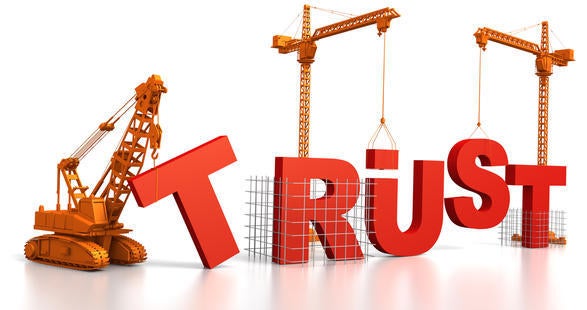
The Human Case For Trust
Social media allows us to have a lot of "connections" - many of them likely being superficial at-best. But we humans still desire a genuine connection. We want to have real relationships with real people and organizations that we trust. As much of innovation these days involves collaboration, trust among fellow employees, as well as between the employee and employer is critical.
"If you don’t have a culture where people feel that it’s OK to take a risk, with the understanding that the risk could fail, you’re unlikely to have much innovation, and a willingness to take on risk is all about trust." --- Alan Webber, Co-Founding Editor, Fast Company, USA
If an organization wants to encourage their people to take the risk of innovation, they need to have the necessary thick skin to receive criticisms that are the starting point of idea generation. It's not enough for the organization to simply say the words; employees need to trust that the words are sincere and that they can take such risks without repercussion.

Trust in the workplace starts at the top of the organization chart, and at the top of each department. It needs to be woven into the fabric of the corporate culture. And it all begins and ends with the people.
Author and Speaker, Brene Brown, discusses The Anatomy of Trust in her appearance on SuperSoul.TV. She notes that, among other things, trust is built in what she refers to as the 'small moments.' Those seemingly insignificant acts - like asking how someone's sick child is doing.
That's called empathy, and it builds trust.
According to Steven Covey, author of The Speed of Trust: The One Thing That Changes Everything: "When trust is low, in a company or in a relationship, it places a hidden "tax" on every transaction: every communication, every interaction, every strategy, every decision is taxed, bringing speed down and sending costs up.
"My experience is that significant distrust doubles the cost of doing business and triples the time it takes to get things done. " --- Steven Covey
Speaker and consultant, Monique Caissie notes that even in mature teams that are used to working together, trust can suffer by adding a newcomer to the team or by modifying a goal.

In her article, How Leaders Can Improve Teamwork And Build Trust, Monique outlines five key things that good leaders will do to introduce trust building actions to the team:
1. Choose to believe and trust. This is where great leaders take their first steps intelligently and with integrity. They choose to believe and trust in the process and in the people they work with.
2. Start with themselves. They make sure they are themselves competent to their job and trustworthy to others who count on them.
3. Declare their intents and assume positive intent in others. Trusting leaders openly express their commitment to trusting others and their expectations that others should be trustworthy.
4. Do what they say they are going to do. These smart leaders can easily follow through on their promises because they only state what they know they can follow through on.
5. Lead out in extending trust to others. Modelling their expectations, they are the first to believe others. They give them chances where others have doubted them.
This fosters good feelings and increases trust. Monique states that:
“When fear is predominant, we convince ourselves that we should wait until others prove themselves to us. That only serves to create suspicion and more fear."
Monique believes that while the trust theories are so logical, they can be difficult to implement because trust-based leadership is not natural for everyone. Healthy human relation habits can be hard and can feel risky to adopt when trust is currently low, but a smart leader knows that someone needs to trust first, and it starts with them.
Related: Building Trust On Virtual Teams
If you're familiar with the work of Simon Sinek, you won't be surprised to know that I am a big fan of his work.
Here's a video of Simon discussing the importance of Trust.
In the meantime...
If you believe that people are a company’s most valuable asset and you’d like to be a contributor to the conversation, you can join our LinkedIn Group or our Facebook Group where you’ll have the opportunity to interact with the collaborators of this series and with others who also believe that people are a company’s most valuable asset.
If you've just discovered this Series and want to know more, consider ordering the #1 best-selling book which is available at Amazon.
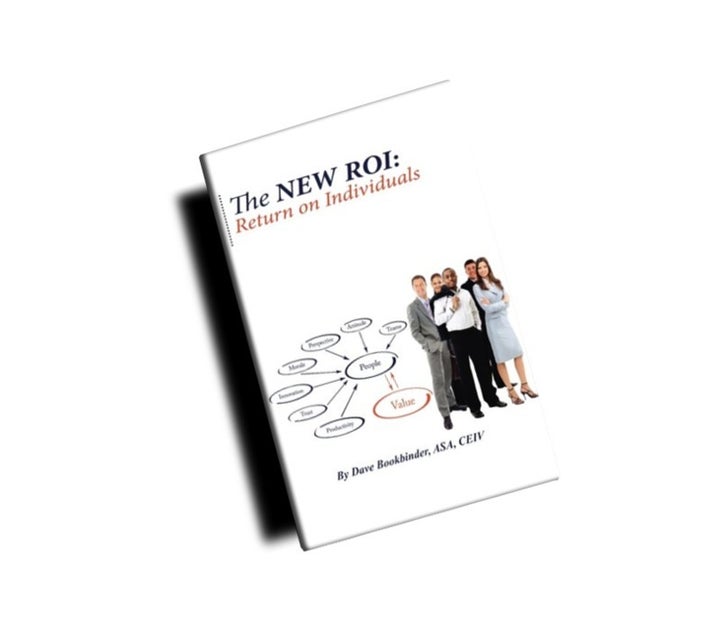
The NEW ROI: Return On Individuals has also been showcased in these articles in Inc. Magazine and at the HuffPost:
About the Author:
Dave Bookbinder is a Director of Valuation Services at EisnerAmper , where he helps his clients with the valuation of businesses, intellectual property, and complex financial instruments.

More than a valuation expert, Dave is a collaborative consultant who serves companies of all sizes, both privately held and publicly-traded. Dave lends his business experiences to help people with a variety of matters.
For future insights and articles, connect with Dave on LinkedIn, like him on Facebook, follow him on Twitter, #NEWROI and subscribe to his blog at Huffington Post.
You might also enjoy some of Dave’s other articles.
Comments and opinions are my own.
About the Collaborators:
The most successful leaders are not infallible when faced with someone who “drives them crazy!” Monique Caissie’s strategies to empower others to stand up and take control of their personal and professional lives are appreciated by all who meet her. Creating collaboration begins with confident conversations. As a Speaker, Facilitator and Consultant, Monique draws from 30 years of crisis intervention work to help others to feel more heard, respected and happier. Check out her website and follow her on Twitter.
Art Dimitri, is the founder of Innovation25 - a management consultancy that helps growing companies grow faster by focusing all their activity solely on their customers. He has previously held leadership positions at a number of technology companies including CA Technology, PLATINUM technology, Aston Brooke Software and Zenith Data Systems. He has served the community as a Board member of the American Society of Inventors and Vice-Chairman of the Greater Philadelphia Senior Executive Group Innovation Leadership Forum.
____________________________________________________________
Copyright 2016 Dave Bookbinder
